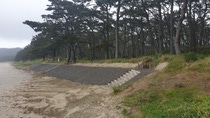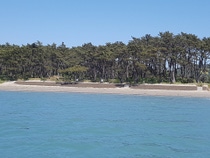BASF defends and restores coastline at South Korea’s largest national park
- Revetments with Elastocoast® now installed on new stretch of Gwanme-do Beach shoreline
- Elastocoast proven to be effective coastal protection solution since 2012
Singapore – August 19, 2019 – Revetments made with BASF’s innovative solution for coastal protection, Elastocoast®, now spans an additional 820m2 of the shoreline at Gwanme-do Beach in South Korea’s largest national park, Dadohae-haesang National Park. The intelligent polyurethane system effectively absorbs the destructive energy of coastal waves and reduces wave run-up, while helping restore ecological balance.
“Coastal erosion has become a major issue for many beaches along the coastline of South Korea. However, the original 300-square-meter revetment built with Elastocoast, installed along the shorelines of Gwanme-do Beach in 2012, has remained intact even after several strong typhoons. As such, it has been recognized by the Korean National Park Service as an excellent solution to protect the coastal line against erosion,” said Mr. Lee TaeHyeong, President of SBB Co., Ltd. “Additionally, the pine groves are thriving, and the shoreline has been repopulated by flora and fauna typical of the local region.”
The coastal protection project at the Dadohae-haesang National Park is a joint project by BASF and SBB using Elastocoast. The two companies have been working together on measures to prevent flooding and erosion since 2010.
Owing to its porous and water permeable structure, Elastocoast is frequently used for the restoration of river ecology and flood risk management. It is also installed in river weirs to transform concrete fishways into natural-looking curved fishways. Elastocoast can be easily installed with light equipment and simple application making coastal protection more flexible, reliable, and economical as compared to other protection systems for coastlines.
“Together with our partner SBB, we have successfully installed Elastocoast in over 30 projects in South Korea. Across Asia, Elastocoast has also helped minimize damage caused by high tides and strong waves to beaches, in Pattaya and Pranburi, Thailand and the Dachi river in Shanghai, China,” said Larsen Kolberg, Head of Business Management, Construction Industry, Performance Materials Asia Pacific, BASF.
About BASF’s Performance Materials division
BASF’s Performance Materials division encompasses the entire materials’ know-how of BASF regarding innovative, customized plastics under one roof. Globally active in four major industry sectors – transportation, construction, industrial applications, and consumer goods – the division has a strong portfolio of products and services combined with a deep understanding of application-oriented system solutions. Key drivers of profitability and growth are our close collaboration with customers and a clear focus on solutions. Strong capabilities in R&D provide the basis to develop innovative products and applications. In 2018, the Performance Materials division achieved global sales of €7.65 bn. More information online: www.plastics.basf.com.
About BASF
At BASF, we create chemistry for a sustainable future. We combine economic success with environmental protection and social responsibility. The approximately 122,000 employees in the BASF Group work on contributing to the success of our customers in nearly all sectors and almost every country in the world. Our portfolio is organized into six segments: Chemicals, Materials, Industrial Solutions, Surface Technologies, Nutrition & Care, and Agricultural Solutions. BASF generated sales of around €63 billion in 2018. BASF shares are traded on the stock exchange in Frankfurt (BAS) and as American Depositary Receipts (BASFY) in the U.S. Further information at www.basf.com.


